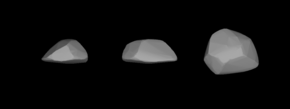 A three-dimensional model of 119 Althaea based on its light curve. | |
| Discovery | |
|---|---|
| Discovered by | James Craig Watson |
| Discovery date | 3 April 1872 |
| Designations | |
| (119) Althaea | |
| Pronunciation | /ælˈθiːə/ [1] |
Named after | Althaea |
| A872 GA; 1972 KO | |
| Main belt | |
| Orbital characteristics [2] | |
| Epoch 31 July 2016 ( JD 2457600.5) | |
| Uncertainty parameter 0 | |
| Observation arc | 143.99 yr (52593 d) |
| Aphelion | 2.7896 AU (417.32 Gm) |
| Perihelion | 2.37335 AU (355.048 Gm) |
| 2.58147 AU (386.182 Gm) | |
| Eccentricity | 0.080623 |
| 4.15 yr (1515.0 d) | |
Average
orbital speed | 18.51 km/s |
| 114.868 ° | |
| 0° 14m 15.472s / day | |
| Inclination | 5.7831° |
| 203.674° | |
| 170.021° | |
| Earth MOID | 1.37297 AU (205.393 Gm) |
| Jupiter MOID | 2.58409 AU (386.574 Gm) |
| TJupiter | 3.413 |
| Physical characteristics | |
| Dimensions | 57.30±1.1 km |
| Mass | 2.0×1017 kg |
Equatorial
surface gravity | 0.0160 m/s2 |
Equatorial
escape velocity | 0.0303 km/s |
| 11.484 h (0.4785 d) [2] [3] | |
| 0.2306±0.010 | |
| Temperature | ~173 K |
| S | |
| 8.42 | |
Althaea ( minor planet designation: 119 Althaea) is a main-belt asteroid that was discovered by Canadian-American astronomer J. C. Watson on April 3, 1872, [3] and named after Althaea, the mother of Meleager in Greek mythology. Two occultations by Althaea were observed in 2002, only a month apart.
Based upon its spectrum, this is classified as an S-type asteroid. [4] Photometric observations made in 1988 at the Félix Aguilar Observatory produced a light curve with a period of 11.484 ± 0.010 hours with a brightness variation of 0.365 ± 0.010 in magnitude. [3]
- ^ Noah Webster (1884) A Practical Dictionary of the English Language
- ^ a b Yeomans, Donald K., "119 Althaea", JPL Small-Body Database Browser, NASA Jet Propulsion Laboratory, retrieved 12 May 2016.
- ^ a b c Hutton, R. G. (June 1990), "V+B Photoelectric Photometry of Asteroid 119 Althaea", The Minor Planet Bulletin, vol. 17, pp. 15–17, Bibcode: 1990MPBu...17...15H.
- ^ DeMeo, Francesca E.; et al. (July 2009), "An extension of the Bus asteroid taxonomy into the near-infrared" (PDF), Icarus, vol. 202, no. 1, pp. 160–180, Bibcode: 2009Icar..202..160D, doi: 10.1016/j.icarus.2009.02.005, archived from the original (PDF) on 17 March 2014, retrieved 8 April 2013. See appendix A.
- 119 Althaea at AstDyS-2, Asteroids—Dynamic Site
- 119 Althaea at the JPL Small-Body Database
 A three-dimensional model of 119 Althaea based on its light curve. | |
| Discovery | |
|---|---|
| Discovered by | James Craig Watson |
| Discovery date | 3 April 1872 |
| Designations | |
| (119) Althaea | |
| Pronunciation | /ælˈθiːə/ [1] |
Named after | Althaea |
| A872 GA; 1972 KO | |
| Main belt | |
| Orbital characteristics [2] | |
| Epoch 31 July 2016 ( JD 2457600.5) | |
| Uncertainty parameter 0 | |
| Observation arc | 143.99 yr (52593 d) |
| Aphelion | 2.7896 AU (417.32 Gm) |
| Perihelion | 2.37335 AU (355.048 Gm) |
| 2.58147 AU (386.182 Gm) | |
| Eccentricity | 0.080623 |
| 4.15 yr (1515.0 d) | |
Average
orbital speed | 18.51 km/s |
| 114.868 ° | |
| 0° 14m 15.472s / day | |
| Inclination | 5.7831° |
| 203.674° | |
| 170.021° | |
| Earth MOID | 1.37297 AU (205.393 Gm) |
| Jupiter MOID | 2.58409 AU (386.574 Gm) |
| TJupiter | 3.413 |
| Physical characteristics | |
| Dimensions | 57.30±1.1 km |
| Mass | 2.0×1017 kg |
Equatorial
surface gravity | 0.0160 m/s2 |
Equatorial
escape velocity | 0.0303 km/s |
| 11.484 h (0.4785 d) [2] [3] | |
| 0.2306±0.010 | |
| Temperature | ~173 K |
| S | |
| 8.42 | |
Althaea ( minor planet designation: 119 Althaea) is a main-belt asteroid that was discovered by Canadian-American astronomer J. C. Watson on April 3, 1872, [3] and named after Althaea, the mother of Meleager in Greek mythology. Two occultations by Althaea were observed in 2002, only a month apart.
Based upon its spectrum, this is classified as an S-type asteroid. [4] Photometric observations made in 1988 at the Félix Aguilar Observatory produced a light curve with a period of 11.484 ± 0.010 hours with a brightness variation of 0.365 ± 0.010 in magnitude. [3]
- ^ Noah Webster (1884) A Practical Dictionary of the English Language
- ^ a b Yeomans, Donald K., "119 Althaea", JPL Small-Body Database Browser, NASA Jet Propulsion Laboratory, retrieved 12 May 2016.
- ^ a b c Hutton, R. G. (June 1990), "V+B Photoelectric Photometry of Asteroid 119 Althaea", The Minor Planet Bulletin, vol. 17, pp. 15–17, Bibcode: 1990MPBu...17...15H.
- ^ DeMeo, Francesca E.; et al. (July 2009), "An extension of the Bus asteroid taxonomy into the near-infrared" (PDF), Icarus, vol. 202, no. 1, pp. 160–180, Bibcode: 2009Icar..202..160D, doi: 10.1016/j.icarus.2009.02.005, archived from the original (PDF) on 17 March 2014, retrieved 8 April 2013. See appendix A.
- 119 Althaea at AstDyS-2, Asteroids—Dynamic Site
- 119 Althaea at the JPL Small-Body Database